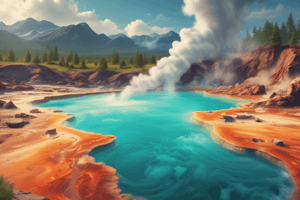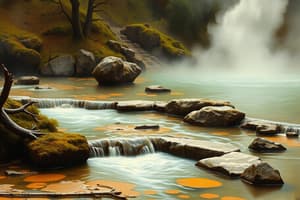Podcast
Questions and Answers
What is the primary heat source for hot springs?
What is the primary heat source for hot springs?
- Wind energy
- Geothermal energy (correct)
- Solar energy
- Fossil fuels
Which type of mountain is formed when magma pushes up through the lithosphere?
Which type of mountain is formed when magma pushes up through the lithosphere?
- Volcanic mountains
- Folded mountains
- Fault-block mountains
- Dome mountains (correct)
What geological feature can sometimes eject a spray of steam and boiling water into the air?
What geological feature can sometimes eject a spray of steam and boiling water into the air?
- Geyser (correct)
- Aquifer
- Hot spring
- Mud pot
How do fault-block mountains form?
How do fault-block mountains form?
Where does groundwater travel to become heated in the context of hot springs?
Where does groundwater travel to become heated in the context of hot springs?
What primarily forms mud pots?
What primarily forms mud pots?
Which layer of the Earth consists of the crust and the deep rock layer affecting mountain formation?
Which layer of the Earth consists of the crust and the deep rock layer affecting mountain formation?
What do bacteria on the ocean floor primarily use to make energy?
What do bacteria on the ocean floor primarily use to make energy?
What causes clouds to form in the atmosphere?
What causes clouds to form in the atmosphere?
Which type of cloud is associated with thunderstorms?
Which type of cloud is associated with thunderstorms?
Which factor does NOT impact climate?
Which factor does NOT impact climate?
What is a key difference between weather and climate?
What is a key difference between weather and climate?
Which of the following is considered one of the five main types of climate?
Which of the following is considered one of the five main types of climate?
What is mechanical weathering?
What is mechanical weathering?
What is the primary cause of erosion?
What is the primary cause of erosion?
What type of glacier is found in mountainous regions?
What type of glacier is found in mountainous regions?
Which type of sedimentary rocks is commonly formed from the accumulation of mineral and organic particles?
Which type of sedimentary rocks is commonly formed from the accumulation of mineral and organic particles?
What does the term 'saltation' refer to in the context of wind erosion?
What does the term 'saltation' refer to in the context of wind erosion?
Which of the following properties is used to describe how shiny a rock is?
Which of the following properties is used to describe how shiny a rock is?
Which type of metamorphism occurs when magma changes rocks near the Earth's surface?
Which type of metamorphism occurs when magma changes rocks near the Earth's surface?
What helps identify the steepness of an area on a topographic map?
What helps identify the steepness of an area on a topographic map?
What are venifacts?
What are venifacts?
What causes streambank erosion?
What causes streambank erosion?
What are the three types of sedimentary rocks?
What are the three types of sedimentary rocks?
Which of the following is NOT a layer of the atmosphere?
Which of the following is NOT a layer of the atmosphere?
Which process describes water turning into gas?
Which process describes water turning into gas?
What type of fossils are evidence of animal activity preserved in rock?
What type of fossils are evidence of animal activity preserved in rock?
What is the most common setting to find fossils?
What is the most common setting to find fossils?
What type of cloud is described as having a puffy appearance?
What type of cloud is described as having a puffy appearance?
Which of the following is a measurement used to assess wind speed?
Which of the following is a measurement used to assess wind speed?
What happens in a low pressure area?
What happens in a low pressure area?
What is the dominant wind pattern called?
What is the dominant wind pattern called?
What is the function of solar radiation on Earth?
What is the function of solar radiation on Earth?
Flashcards are hidden until you start studying
Study Notes
Hot Springs and Geothermal Energy
- Hot springs are naturally occurring springs of water warmed by geothermal energy from within Earth.
- A hot spring's temperature generally ranges from 37°C to over 100°C.
- Most hot springs form when rain or groundwater seeps deep underground through cracks, heated by magma.
- Magma, molten rock beneath the surface, expands water, making it less dense, causing it to rise and form springs.
- Hot spots are regions where magma is near the Earth's surface, providing heating.
- Geysers are hot springs that intermittently eject steam and boiling water.
- Mud pots form in acidic conditions where standing water dissolves surrounding rock into clay.
Mountain Formation and Types
- Mountains form due to movements of the tectonic plates within the lithosphere (earth's crust and underlying rock).
- Types of mountains include:
- Dome Mountains: Formed by magma pushing the crust upward.
- Volcanic Mountains: Created by eruptions through vents in the lithosphere.
- Fault-block Mountains: Result from the crust pulling apart, causing sections to sink or rise.
- Folded Mountains: Arise when tectonic plates push against each other.
Ocean Floor Features
- The ocean floor contains various geological features like volcanoes, trenches, and mountains.
- Bacteria in deep-sea environments derive energy from chemicals rather than sunlight.
- Hydrothermal vents provide warm habitats for unique ecosystems.
Topography and Mapping
- Topography studies the physical features of land, which can be analyzed using topographic maps.
- Contour lines on maps indicate changes in elevation; more lines denote steeper terrain, while fewer lines show flatter areas.
Weathering Processes
- Weathering breaks down large rocks into smaller pieces and has three types:
- Mechanical Weathering: Physical breakdown without altering mineral composition.
- Chemical Weathering: Changes mineral composition through chemical reactions (e.g., oxidation).
- Organic Weathering: Involves living organisms contributing to rock breakdown.
Erosion and Its Causes
- Erosion is the movement of debris by natural forces such as water, ice, and wind.
- Types of water erosion include:
- Inter-rill Erosion: Small craters formed by raindrops.
- Rill Erosion: Water creates small channels.
- Gully Erosion: Large channels exceed one foot in depth.
- Streambank Erosion: Large bodies of water erode the surrounding land.
Wind Erosion
- Wind erosion transports rocks and sediments by air movement and includes:
- Creep: Larger particles rolling along the surface.
- Saltation: Particles bouncing along the ground.
- Suspension: Fine particles lifted and suspended in the air.
- Aeolian landforms resultant from wind erosion include sand dunes, ventifacts, and yardangs.
Glaciers
- Glaciers are large ice masses formed by compacting layers of snow and ice.
- Two main types exist:
- Alpine Glaciers: Found in mountain regions.
- Continental Glaciers: Cover vast land areas, predominantly in Antarctica and Greenland.
Soil Composition
- Soil is the upper layer of Earth, containing minerals, organic materials, and living organisms.
- It supports ecosystems through the decomposition of organic matter by organisms like earthworms.
Rock Properties and Classification
- Rocks consist of minerals with distinct properties, such as streak (color when powdered) and luster (shininess).
- The rock cycle describes how rocks transform between types:
- Igneous Rock: Formed from cooled magma or lava.
- Sedimentary Rock: Compressed layers of sediment.
- Metamorphic Rock: Altered by heat and pressure.
Fossil Formation
- Fossils can be categorized as:
- Trace Fossils: Evidence of organism activity.
- Body Fossils: Preserved remains of plants or animals.
- Sedimentary rocks are the primary source for fossils, which can be found globally.
Water Cycle
- The water cycle consists of evaporation, condensation, precipitation, and collection.
- Each stage is critical in the movement of water through different environments.
Cloud Types
- Main cloud types include:
- Cumulus: Puffy, white clouds resembling cotton balls.
- Stratus: Flat, sheet-like clouds.
- Alto: Comprised of water and ice droplets.
- Cirrus: Wispy clouds indicating fair weather.
Atmosphere Layers
- The atmosphere consists of five layers: Troposphere, Stratosphere, Mesosphere, Thermosphere, and Exosphere.
Solar Radiation
- Solar radiation (sunlight) travels to Earth as electromagnetic waves necessary for life, providing visible light, heat, and UV radiation.
Wind and Air Pressure
- Wind is caused by temperature differences affecting air pressure.
- Tools to measure wind include an anemometer and the Beaufort scale (0-12 wind strength).
Air Masses and Weather
- Air masses gain characteristics based on their formation locations (e.g., continental, maritime, tropical, polar).
- Jet streams can cause air masses to move, creating weather fronts where dissimilar air masses collide, leading to varying weather conditions.
Weather and Climate
- Weather refers to atmospheric conditions at any moment, influenced by solar energy.
- Climate is weather patterns over long periods, affected by factors like temperature, humidity, altitude, and geography.
- Recognized climate types include tropical, dry, mild, continental, and polar.
Studying That Suits You
Use AI to generate personalized quizzes and flashcards to suit your learning preferences.




